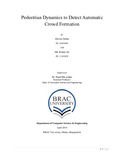| dc.contributor.advisor | Azhar, Hanif Bin | |
| dc.contributor.author | Sarkar, Shovan | |
| dc.contributor.author | Ali, Md. Refaat | |
| dc.date.accessioned | 2014-05-14T04:57:11Z | |
| dc.date.available | 2014-05-14T04:57:11Z | |
| dc.date.copyright | 2014 | |
| dc.date.issued | 2014-04 | |
| dc.identifier.other | ID 10101004 | |
| dc.identifier.other | ID 11101028 | |
| dc.identifier.uri | http://hdl.handle.net/10361/3223 | |
| dc.description | This thesis report is submitted in partial fulfillment of the requirements for the degree of Bachelor of Science in Computer Science and Engineering, 2014. | en_US |
| dc.description | Cataloged from PDF version of thesis report. | |
| dc.description | Includes bibliographical references (page 44). | |
| dc.description.abstract | In our work, we are trying to implement such a system that itself can predict whether there is a chance of forming a crowd in a public place or not, which will enrich the entire security system in such a way that the authority will be able to take precautions and avoid unexpected incidents. This system will work by using security cameras to take live streaming, identify each moving elements and analyze their movements. First we will take live streaming from security cameras and then we split the video into frames. Here we can split the video into 25-35 frames per second of playing time. Then we analyzed each frames and identify each moving elements and analyze their movements. First we will take live streaming from security cameras and then we split the video into frames. Here we can split the video into 25-35 frames per second of playing time. Then we analyzed each frames and identify each moving object and assign them with a unique object identification number. We also highlight the object with a rectangle box so in order to make it distinctive. We collect the data of each frame and save them in a data structure. Our algorithm does calculations on those data and predicts the next possible location of structure. Our algorithm does calculations on those data and predicts the next possible location of each object and therefore we can predict the possible location for a crowd. Apart from crowd detection, our research also extracts features from the movement of each objects (in this case pedestrian) and also predicts what will be the position of the object in future, whether a crowd has already formed or not , if someone is suspiciously standing in a busy way etc. | en_US |
| dc.description.statementofresponsibility | Shovan Sarkar | |
| dc.description.statementofresponsibility | Md. Refaat Ali | |
| dc.format.extent | 45 pages | |
| dc.language.iso | en | en_US |
| dc.publisher | BRAC University | en_US |
| dc.rights | BRAC University thesis are protected by copyright. They may be viewed from this source for any purpose, but reproduction or distribution in any format is prohibited without written permission. | |
| dc.subject | Computer science and engineering | |
| dc.title | Pedestrian dynamics to detect automatic crowd formation | en_US |
| dc.type | Thesis | en_US |
| dc.contributor.department | Department of Computer Science and Engineering, BRAC University | |
| dc.description.degree | B. Computer Science and Engineering | |

